Day Hike at the Laurels Preserve--7/29/05
 The Laurels Preserve is a property managed by the Brandywine Conservancy, which we belong to as members of the Brandywine River Museum. It's only open 9:00 a.m.-5:00 p.m. Wednesdays through Sundays, but even with the limited hours, it's a great place to go for a mid-morning or afternoon hike. The fact that entrance is limited to conservancy members means that you're likely to have a fairly private hike. The Preserve is a great place to go to see why the southern Chester County area is known as the mushroom capital of the world. The abundant native species are indicative of why the cultivated species do so well.
The Laurels Preserve is a property managed by the Brandywine Conservancy, which we belong to as members of the Brandywine River Museum. It's only open 9:00 a.m.-5:00 p.m. Wednesdays through Sundays, but even with the limited hours, it's a great place to go for a mid-morning or afternoon hike. The fact that entrance is limited to conservancy members means that you're likely to have a fairly private hike. The Preserve is a great place to go to see why the southern Chester County area is known as the mushroom capital of the world. The abundant native species are indicative of why the cultivated species do so well.I am going to attempt to identify the species of mushrooms that I've photographed, but I'd like to add the disclaimer that identifying mushrooms is a harzardous endeavor, and so these are my best guesses and should not be taken as a guide to identifying edible mushrooms. Proceed at your own peril.
The first picture (above) seems to be of a Chanterelle Waxy Cap (Hygrophorus cantharellus - Hygrophoraceae, Agaricales). The species is described by the National Audobon Society Field Guide to North American Mushrooms (1995) as "small, dry, red-orange cap with orange-yellow gills descending dry stalk" (656). I thought the gills on the one I saw were whitish rather than orange-yellow, but the photograph in the field guide appears to have gills that are more whitish than orange-yellow too. These mushrooms are listed as edible. The range is eastern North America.
 I'm really not sure what this is, but I'm guessing that it's a Cinnabar-red Chanterelle (Cantharellus cinnabarinus - Cantharellaceae, Aphyllophorales). The Audubon field guide describes it as "small, reddish-orange cap with pinkish, forked, thick-edged ridges descending dull red stalk" (388). The edibility is listed as "good," the season as late June-October and the range as E. Canada to Florida and west to Indiana.
I'm really not sure what this is, but I'm guessing that it's a Cinnabar-red Chanterelle (Cantharellus cinnabarinus - Cantharellaceae, Aphyllophorales). The Audubon field guide describes it as "small, reddish-orange cap with pinkish, forked, thick-edged ridges descending dull red stalk" (388). The edibility is listed as "good," the season as late June-October and the range as E. Canada to Florida and west to Indiana. This species appears to be a Yellowish-White Melanoleuca (Melanoleuca alboflavida - Tricholomataceae, Agaricales). It's described by the Audubon field guide as "whitish to buff cap with white gills and slender, straight, white stalk with twisted lines of dark fibers" (776). It's listed as edible, with a season from June-September, and a range of east of the Great Plains.
This species appears to be a Yellowish-White Melanoleuca (Melanoleuca alboflavida - Tricholomataceae, Agaricales). It's described by the Audubon field guide as "whitish to buff cap with white gills and slender, straight, white stalk with twisted lines of dark fibers" (776). It's listed as edible, with a season from June-September, and a range of east of the Great Plains. I believe this species and the one after it to be Chanterelles. According to the Audubon field guide, the Chanterelle family includes some of the best known edible wild mushrooms. However, Chanterelles are frequently mistaken for the poisonous Jack O'Lantern (also known as "The False Chanterelle"), and so I'd have to investigate this further with the field guide in hand and the opportunity to examine all aspects of these mushrooms in person (spore print, gills identification, etc.) before I'd pick one of these and eat it. Sorry my identification isn't more helpful.
I believe this species and the one after it to be Chanterelles. According to the Audubon field guide, the Chanterelle family includes some of the best known edible wild mushrooms. However, Chanterelles are frequently mistaken for the poisonous Jack O'Lantern (also known as "The False Chanterelle"), and so I'd have to investigate this further with the field guide in hand and the opportunity to examine all aspects of these mushrooms in person (spore print, gills identification, etc.) before I'd pick one of these and eat it. Sorry my identification isn't more helpful.
 Here's another case of the difficulty in identifying mushrooms in the field. This mushroom could be a deadly (not just poisonous, but deadly) Destroying Angel (Aminita virosa - Amanitaceae, Agaricales) or a Tiny Volvariella (Volvariella Pusilla - Pluteaceae, Agaricales), which also does not appear to be edible.
Here's another case of the difficulty in identifying mushrooms in the field. This mushroom could be a deadly (not just poisonous, but deadly) Destroying Angel (Aminita virosa - Amanitaceae, Agaricales) or a Tiny Volvariella (Volvariella Pusilla - Pluteaceae, Agaricales), which also does not appear to be edible.The Destroying Angel is described as "white mushroom with flaring to ragged ring on stalk; large, saclike cup about base" (551). The range is described as throughout North America. The Audubon guide also notes "The Destroying Angel, one of the most strikingly beautiful of our mushrooms, is usually found alone or in a small, scattered group, shining white against a green or brown backdrop" (551-2). The symptoms of poisoning are then described and are not pretty.
The Tiny Volvariella is described as "tiny, white cap with free, pink gills and saclike cap about stalk base; on ground" (678). Both of these types of mushrooms have something going on around the base of the stalk, so I would need to investigate this further with field guide in hand before I'd try to eat one of these. The range for the Tiny Volvariella is described as Quebec and Eastern U.S.
 This appears to be a Yellow-Latex Milky (Lactarius vinaceorufescens - Russulaceae, Agaricales). The range is described as Nova Scotia to North Carolina, and west to Wisconsin, and the mushroom is listed as "possibly poisonous." I don't think I'll try to find out. The Audubon field guide notes "In the Northeast, this is the most common milky with white latex that turns yellow" (696).
This appears to be a Yellow-Latex Milky (Lactarius vinaceorufescens - Russulaceae, Agaricales). The range is described as Nova Scotia to North Carolina, and west to Wisconsin, and the mushroom is listed as "possibly poisonous." I don't think I'll try to find out. The Audubon field guide notes "In the Northeast, this is the most common milky with white latex that turns yellow" (696). I'm not sure if this is a Sweetbread Mushroom (Clitopilus prunulus - Entolomataceae, Agaritcales) or a Giant Clitocybe (Clitocybe gigangtea - Tricholomataceae, Agaricales). The Sweetbread Mushroom is described as "dry, white to grayish cap with white to pinkish gills descending stalk" (641), while the Giant Clitocybe is described as "very large, white to buff cap with crowded white gills slightly descending short, stout, whitish stalk" (748). The Sweetbread Mushroom is described as 2-4 inches in diameter, while the Giant Clitocybe is described as 4-18 inches in diameter. This one was about 4-5 inches across, so I'm leaning toward the Giant Clitocybe. The "short, stout, whitish stalk" also sounds more like the Giant Clitycobe, although I'm not sure this specimen had a whitish stalk, just short and stout. Both are listed as edible, although the Sweetbread Mushroom is listed as "good," and a note in the Audubon guide adds "as its common name implies, this is an excellent edible mushroom" (641). Both mushrooms are listed as widely spread in North America, although the Giant Clitocybe is most commonly found in the Pacific Northwest.
I'm not sure if this is a Sweetbread Mushroom (Clitopilus prunulus - Entolomataceae, Agaritcales) or a Giant Clitocybe (Clitocybe gigangtea - Tricholomataceae, Agaricales). The Sweetbread Mushroom is described as "dry, white to grayish cap with white to pinkish gills descending stalk" (641), while the Giant Clitocybe is described as "very large, white to buff cap with crowded white gills slightly descending short, stout, whitish stalk" (748). The Sweetbread Mushroom is described as 2-4 inches in diameter, while the Giant Clitocybe is described as 4-18 inches in diameter. This one was about 4-5 inches across, so I'm leaning toward the Giant Clitocybe. The "short, stout, whitish stalk" also sounds more like the Giant Clitycobe, although I'm not sure this specimen had a whitish stalk, just short and stout. Both are listed as edible, although the Sweetbread Mushroom is listed as "good," and a note in the Audubon guide adds "as its common name implies, this is an excellent edible mushroom" (641). Both mushrooms are listed as widely spread in North America, although the Giant Clitocybe is most commonly found in the Pacific Northwest.I'm not sure if the mushroom below is a Chanterelle or not. Further investigation is needed.
I have no idea what the mushroom below is. I think it's a Bolete, but since that family includes not only some of the most prized edible mushrooms but also a few poisonous ones, I think much further investigation is needed before feeling confident about the type of mushroom this is.
I believe the species in the next two pictures is a Black Trumpet (Craterellus fallax - Cantharellaceae, Aphyllophorales), which is described in the Audubon field guide as "vase-shaped mushrooms with small, flat, brownish scales on top and within; outer surface smooth to wrinkled, gray to dark brown to black; fragrant" (394). Their edibility is listed as "choice," and they range throughout North America. The guide notes "this fragrant mushroom is often smelled before it is seen. Look for it along paths in oak and beech woods. It is excellent in flavor and texture when added to other foods and is preserved best by drying" (395).


 Further investigation needed on this one.
Further investigation needed on this one.
Further investigation needed on this one too. The mushrooms, although colorful, are indistinct in the picture, but I couldn't resist including it because of the color and because of the hairy moss.

 I'm pretty sure this is a white dwarf, which we oftentimes find in our lawn. It's also listed as edible, but I have no idea whether it is very tasty.
I'm pretty sure this is a white dwarf, which we oftentimes find in our lawn. It's also listed as edible, but I have no idea whether it is very tasty.
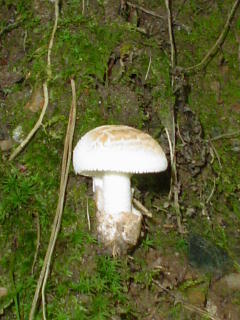 This appears to be an Armillaria mushroom, but there are several different varieties, so I can't say which one it is. At least a couple of the Armillaria varieties are listed as "edible" or even "choice," but I wouldn't want to risk it until I was sure what variety it is.
This appears to be an Armillaria mushroom, but there are several different varieties, so I can't say which one it is. At least a couple of the Armillaria varieties are listed as "edible" or even "choice," but I wouldn't want to risk it until I was sure what variety it is.
 The trail leading deeper into the woods along the east side of the Laurels Preserve. Most of the varieties of mushrooms that I photographed were along the righthand side of this trail. There are side trails leading off this main trail which are much narrower and not necessarily listed on the trail map for the preserve, but I was wearing sandals on this spontaneous hike, so I stayed on the main trail.
The trail leading deeper into the woods along the east side of the Laurels Preserve. Most of the varieties of mushrooms that I photographed were along the righthand side of this trail. There are side trails leading off this main trail which are much narrower and not necessarily listed on the trail map for the preserve, but I was wearing sandals on this spontaneous hike, so I stayed on the main trail.
Looking up through the trees above the trail.

Even though this isn't a very clear picture, this appears to be several Shiny Cinnamon Polypores (Coltricia cinnamonea - Polyporaceae, Aphyllophorales). The Audubon field guide describes them as "small, thin, reddish-brown, silky, shiny, zoned cap with brownish pores and velvety, reddish-brown stalk; on ground" (450). Their habitat is described as "single, in hard-packed soil, along paths and in dense moss" (451). Their range is from eastern Canada and Maine to Louisiana, in the Midwest, and in California.
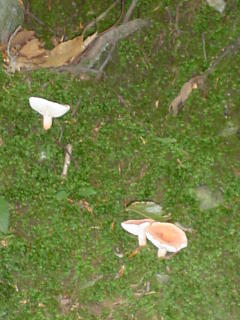 Picture is too unclear. Further investigation needed.
Picture is too unclear. Further investigation needed.
Can you see the toad?

These appear to be Peppery Milky mushrooms (Lactarius piperatus - Russulaceae, Agaricales). The Audubon field guide describes them as "common, white mushrooms with densely crowded, narrow gills" (690) and lists the range as eastern North America west to Michigan. The mushrooms are listed as "edible with caution," and the field guide further notes "this edible is too acrid to be tasty without first being parboiled. A variety, glaucescens, has latex that dries greenish; it is reportedly poisonous" (690).
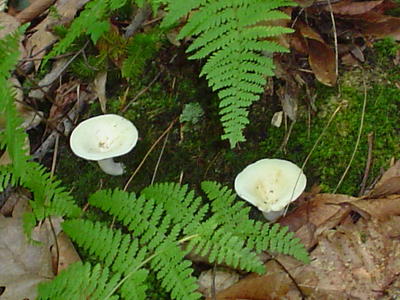
 I wouldn't swear to it, but this mushroom and the one after it appear to be Funnel Clitocybe mushrooms (Clitocybe gibba - Tricholomataceae, Agaricales). They're much pinker than the photo in the Audubon guide, but they fit the description: "sunken to funnel-shaped, red- to pink-tan cap with white gills descending stalk" (747).
I wouldn't swear to it, but this mushroom and the one after it appear to be Funnel Clitocybe mushrooms (Clitocybe gibba - Tricholomataceae, Agaricales). They're much pinker than the photo in the Audubon guide, but they fit the description: "sunken to funnel-shaped, red- to pink-tan cap with white gills descending stalk" (747). Both of these had larger caps than the 2- to 3-inch cap listed for the Funnel Clitocybe, but the Audubon guide does note that there is a larger variety (C. maxima) that becomes funnel-shaped with age and has a stout stalk and a strong odor. I didn't notice a strong odor, but these definitely have stout stalks and a funnel shape. They are listed as edible and as having a range from Quebec to Florida to the West Coast.
Both of these had larger caps than the 2- to 3-inch cap listed for the Funnel Clitocybe, but the Audubon guide does note that there is a larger variety (C. maxima) that becomes funnel-shaped with age and has a stout stalk and a strong odor. I didn't notice a strong odor, but these definitely have stout stalks and a funnel shape. They are listed as edible and as having a range from Quebec to Florida to the West Coast.
The view on the trail heading back toward the trailhead.
One of two covered bridges in the Laurels Preserve. Both of the covered bridges are on the same trail that is west of the trail that I took.
Horses in a field on on PA 82 near the Laurels Preserve.
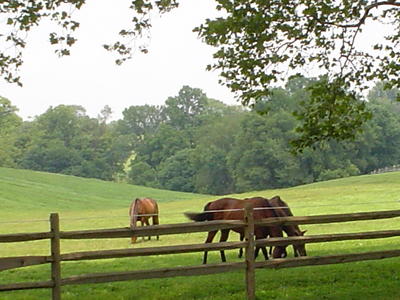
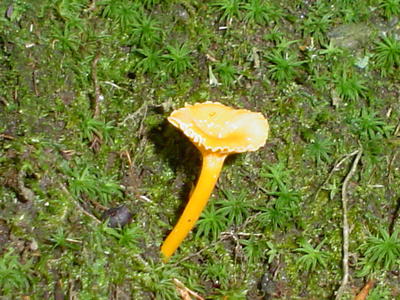




1 Comments:
I have the same audubon book. I wonder whether several of your pictures (e.g., your clitocybe guess) were milkies, such as hygrphorus milky Pic # 290; Voluminous Latex # 291. They are delicious, both. (Key difference is width of gills.)
One may be a Peck's Milky as I think I saw a circular target ring"zoned" top. Pic 292.
As guide states, ALWAYS do spore check.
I think I've seen a pic in that book that looks like the unidentified shiny metallic orangish mushrooms. Hope all is well with you and your.
(I don't have your pics available as I type this.)
RL
Post a Comment
<< Home